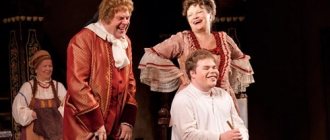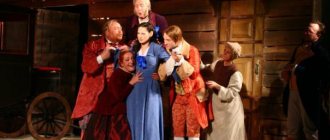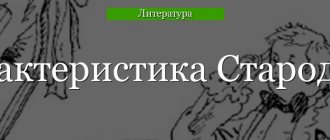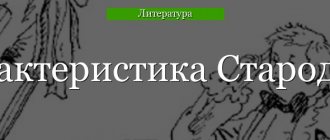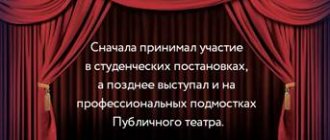Features of classicism in the comedy of D.I. Fonvizin "Minor"
The comedy “The Minor” was written by D. I. Fonvizin in 1781 and became the pinnacle of Russian drama of the 18th century. This is a work of classicism, but it also displays certain features of realism, which makes this work innovative.
Classicism is a literary movement based on the principles of philosophical rationalism, the ideal of harmony and measure, strict adherence to normativity in poetics, imitation of examples of ancient literature, and faith in human reason. Harmony of content and form, strict division of heroes into positive and negative, the use of “speaking” surnames, the rules of the “three unities”, adherence to the hierarchy of genres - these are the main features of classicism.
Russian classicism is distinguished by the satirical orientation of its works, the predominance of national historical themes over ancient ones.
D. I. Fonvizin observes the unity of place and time in “Nedorosl”: all the events of the comedy take place in the house of Mrs. Prostakova and the action takes place within 24 hours. But the author of the comedy violates the unity of action, since there are two conflicts in the work: love and socio-political. Love conflict is the main one. The heroes of the comedy are divided into negative (Mrs. Prostakova, Mr. Skotinin) and positive (Milon, Starodum, Sophia). The author gives the characters “speaking” surnames: Pravdin, Skotinin, Vralman. The positive heroes - Starodum, Sophia, Milon - speak the correct literary language, their speech is instructive; negative characters use colloquial words, swear words, their speech is more lively (for example, Prostakova says: “And you, cattle, come closer. Didn’t I tell you, you thieving mug, that you should let your caftan widen. <...> Tell me, idiot , how will you justify yourself?”). The speech of the heroes is a means of characterizing the heroes. The connection with folklore is clearly visible: the characters in conversation use proverbs and sayings that make the comedy “folk” (for example, “Everyone should marry his bride,” “Live and learn,” “I don’t want to study, I want to get married”).
The comedy has an educational orientation, since it touches on the most important issues of upbringing a citizen, education, morality, and the arbitrariness of landowners. The comedy was topical in nature, because D.I. Fonvizin showed all the hardships of serfdom and the shortcomings of education. This play became the predecessor of A. S. Griboyedov’s comedy “Woe from Wit” .
Traditions of classicism in Fonvizin’s comedy “The Minor”
There, in the old days, the brave ruler of Satire, Fonvizin, the friend of freedom, shone... A. S. Pushkin
Classicism is a literary movement that existed in the 18th - early 19th centuries. It was characterized by a high civic theme, which demanded that everything personal be sacrificed in the name of national goals; strict adherence to certain norms and rules. Classical writers found examples of beauty in the monuments of ancient art, unchanged for all times.
In classicism there was a clear division of literary genres into “high” and “low”. The subject of high genres (poems, odes, tragedies) was supposed to be a higher, spiritual life; the characters were only kings and aristocrats. The content of low genres (satire, comedy, fable) was reduced to depicting private, everyday life. The characters were representatives of the lower classes - the small nobility, bureaucrats, serf servants. “High” and “low” have never been combined in one work. The character of the hero was dominated by a single trait - positive or negative. As a result, the characters were either completely vicious or completely noble.
Classicism solved the problems of educating a citizen. The behavior of others has a decisive influence on the child's personality. Virtuous or vicious, it serves as an example, a role model. The ideal of the era is proclaimed to be a person capable of bringing public benefit, for whom the interests of the state are above personal interests. The comedy's attention was drawn to the negative phenomena of reality. The purpose of comedies, according to classicism, is to educate, ridicule shortcomings, and educate with laughter.
The most outstanding work of classicist drama in Russian literature of the 18th century is Fonvizin’s comedy “The Minor.” In constructing his play, Fonvizin strictly followed the rules of classicism. "Minor" consists of five canonical acts. Each follows the rule of the trinities - action, time and place. The events depicted by Fonvizin take place over the course of one day and in one place - in the house of the landowner Prostakova.
According to the rules of classicism, the characters in the comedy are divided into vicious and virtuous, and in the finale of the play the evil ones are punished, the good ones triumph. Comic heroes are put to shame. Prostakova was deprived of her rights over the peasants for abusing her power, and her estate was taken under guardianship.
The clash between the “evil” and “virtuous” heroes reflects the deep social conflict between the advanced noble intelligentsia and the reactionary feudal landowners. The playwright deliberately sharpens negative images, thereby achieving greater persuasiveness in denouncing serfdom.
The images of positive comedy characters are schematic in the spirit of classicism. Pravdin, Starodum, Milon, Sophia do not so much live and act as they talk at length and importantly on moral and political topics, teach lessons about noble virtues.
Like these positive heroes of the play, its negative characters are endowed with “talking” names, by which one can immediately judge each of them: Prostakov, Vralman, Skotinin.
Three themes run through Fonvizin’s dramatic work: the theme of education, serfdom and the state structure of Russia.
The problem of upbringing and education of young nobles deeply worried the playwright, who dreamed of a new generation of enlightened Russian people. According to Fonvizin, the only reliable source of salvation from the spiritual degradation of the nobility is rooted in proper education. Fonvizin raised the question of what a true nobleman should be and whether the Russian nobility meets its purpose. Starodum expressed the following thought about this: “A nobleman, for example, would consider it the first dishonor to do nothing when he has so much to do: there are people to help, there is a fatherland to serve!” Material from the site //iEssay.ru
Another problem of “Minor” is the problem of serfdom: the terrible situation of Russian serfs, given over to the full ownership of the landowners, the monstrous tyranny of the nobles. The writer, speaking out in favor of curbing the ignorant landowners who abused their power over the peasants, shows that faith in Catherine II is meaningless. In response to Pravdin’s words that with such rules, “as Starodum has them, people should not be released from the court, but people must be called to the court... for what they call a doctor to the sick for,” Starodum replies with complete conviction: “My friend, you are wrong. It is in vain to call a doctor to the sick without healing: here the doctor will not help unless he himself becomes infected.” The author puts another thought into Starodum’s mouth: “It is unlawful to oppress one’s own kind through slavery.”
Thus, the comedy “Nedorosl” reflected the most important and pressing problems of Russian life. Fonvizin believed that the main weapon of a comedian is laughter and vice can and should be portrayed as funny.
Didn't find what you were looking for? Use search ↑↑↑
On this page there is material on the following topics:
- classicism in Russian literature undergrowth
- classicism in its infancy
- traditions in comedy undergrowth
- undergrowth as a comedy of classicism
- Russian classicism using the example of the Comedy Minor
“Classicism in dramaturgy. Comedy "The Minor" by D. I. Fonvizin"
Classicism in drama. Comedy “The Minor” by D. I. Fonvizin 1. The conflict of the comedy “The Minor.” 2. Traditions of classicism and innovation by D. I. Fonvizin. 3. “The Minor” is a realistic comedy. Literature of the 18th century, during the general national upsurge, formed civic consciousness in society. The classicists propagated the ideas of equality of people, humanism, the principle of common benefit, and the responsibility of authorities to the people. They considered it their duty to benefit their fatherland. The classicists strove for a truthful depiction of life, spoke about current problems of society, they were characterized by civic pathos and patriotism. But the dramaturgy of that time was also enriched with works that went beyond classicism. This is the comedy by D. I. Fonvizin “The Minor”. The comedy was completed in 1781. Its pathos was determined by Fonvizin’s political acuity and commitment to the ideals of human freedom.
The main theme of the comedy, its conflict is indicated by the author at the very beginning, this is the arbitrariness of the landowners and the lack of rights of the serf. The struggle of the progressive nobility against the serf-owners is the dramatic conflict of “The Minor.” On the side of the progressive nobility are Pravdin and Starodum, the serf owners are the Prostakovs and Skotinins. Fonvizin convinces us that serfdom is destructive and must be fought. It corrupts the serf owners themselves, who lose their human qualities in dealing with the serfs and feel omnipotent. The author wanted to show in his work the actions and morality of serf owners generated by serfdom. It is serfdom's tyranny, and not the struggle for Sophia's hand, that is the main theme of "The Minor." The depiction of the suitors for her hand is another opportunity to carefully consider the representatives of the “noble class” depicted in a comic light. A love plot, according to Fonvizin, cannot be the basis of a dramatic work. It was based on the conflict of the era.
Literary critic G. P. Makogonenko believes that “The Minor” is a political comedy, since the innovative features in it were determined precisely by the political beliefs of the author. There is a plot here that conveys a real historical conflict; positive heroes with the features of noble enlighteners.
The play continues the traditions of classicism. According to G. A. Gukovsky, Fonvizin’s artistic thinking always “retained a clear imprint of this school.” “Nedorosl” is a phenomenon of late Russian classicism, which was influenced by Enlightenment ideology. This work combines the touching and the comic and destroys the usual genre forms. The characters of the heroes are complex, contradictory, they are not divided only into positive and negative, as required by the principles of classicism. But the positive heroes, following the canons of classicism, in “The Minor” have one characteristic feature. The power of the traditions of classicism was preserved in the speaking surnames of the heroes, in maintaining symmetry in the distribution of negative and positive characters. The speech of the characters in the play conveys the characters of the characters, but the hero-reasoner, in classic works - the bearer of the author's opinion, is also present, this is the noble Starodum. The main idea of classicism is the idea of enlightenment. In “The Minor,” she receives a different interpretation: enlightenment is important, but virtue is more important than intelligence. The trinity of time, place and action is broken: instead of one problem, the author touches on a number of equally important ones.
Fonvizinsky realism - truthfulness, historical concreteness of images, especially clearly manifested itself in the creation of the characters of Eremeevna and Prostakova, showing the complexity of their nature. The images of Starodum and Pravdin are also living characters; readers even “recognized” their prototypes, noble enlighteners. Realism helped Fonvizin move away from literary cliches; the author was the first to take a step towards creating a leading figure hero. Starodum, Pravdin and Milon are written out in general terms, without details of their biography or inner world. But the image of Starodum is more significant in this regard.
Fonvizin created a new type of realistic comedy: he based it not on a ready-made plot, but on a real historical conflict that affects all the characters. Conflicts in the house, according to the author, are a reflection of conflicts in the country. Prostakova’s behavior, for example, comes from the decree on the liberties of the nobility. Condemning her means that serfdom is condemned in her person. But high content does not mean for the author a rejection of the comic. But this is an accusatory comedy, and sometimes with bitter irony. Russian social comedy begins with “The Minor.” Fonvizin gave the comedy social depth and a sharp satirical orientation. The author denounces the vice - serfdom, noble "evil morality" and seeks to show its causes: improper upbringing, ignorance of people.
According to G. A. Gukovsky, “The Minor” is “half comedy, half drama.” The genre originality of the work is that the basis of the play is a classic comedy, updated with serious and touching scenes: Pravdin’s conversation with Starodum, Starodum’s conversations with Sophia and Milon. The ending combines moralizing and touching. Prostakova suffered punishment, but I feel sorry for her.
Fonvizin’s traditions were continued by his followers - A. S. Griboyedov with his “Woe from Wit” and N. V. Gogol with “The Inspector General”. Gogol called the comedies of Fonvizin and Griboedov the most striking works: “They no longer contain light ridicule of the funny aspects of society, but the wounds and illnesses of our society... Both comedies took place in two different eras. One was struck by illnesses from lack of education, the other from ill-understood enlightenment.”
How to distinguish a classic work? Signs of classicism in the comedy “Minor”
| Conditional division of characters into positive and negative | |
| Using speaking surnames | Skotinin, Vralman - negative characters; Milon, Pravdin - positive. |
| The presence of a reasoning hero | |
| Rule of three unities (time, place, action) | Events take place in Prostakova’s house during the day. The main conflict is love. |
| The characters behave according to the specifics of the genre - low and mean | The speech of Prostakova and other negative characters is vile and simple, and their behavior confirms this. |
The work consists of actions (usually 5 of them) and phenomena, and the subject of conversation in classical comedy is the state. The author also observes these signs of classicism in “The Minor” and “The Brigadier”.
